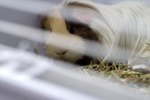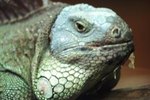
Some reptiles, particularly rainforest species like four-horned chameleons (Chamaeleo quadricornis), emerald tree boas (Corallus caninus) and red-footed tortoises (Geochelone carbonaria), require high humidity to thrive. Meanwhile, other reptiles, like anoles (Anolis sp.), don’t recognize standing water for what it is; instead they'll recognize droplets of water provided by the keeper.
Handheld Misting System
The simplest way to increase humidity and provide droplets of water for your pet to drink is by using a hand-held misting bottle. Use room-temperature dechlorinated water or spring water when misting the cage. Mist the cage every morning so that all the surfaces dry out by the end of the day. Avoid keeping the cage damp and poorly ventilated. Soak the well-vented cage thoroughly, spraying the cage walls and furnishings. Some animals respond well to misting and will immediately begin drinking when being misted. Don't startle the animal by misting it abruptly or in the face; begin with a few gentle drops on the animal's back or tail. If you have more than a few cages to mist, consider spending a few more dollars and purchasing a commercial sprayer bottle from a home improvement store. These units consist of large, pressurized reservoirs that use a hand pump to quickly build pressure to propel the water. Commercial units are available in 5-gallon hand-held models as well as larger, canister and backpack style units. The ease of use of these commercial units -- particularly for those tending large cages or collections -- easily offsets the extra cost.
Automatic Misting Systems
For those with large collections or severe time constraints, an automatic misting system mists each cage once or twice a day. An automatic misting system consists of a timer and control system, a water reservoir, several lengths of tubing and connectors, and nozzles that spray the water into the cages. Misting systems vary greatly in their features, reliability, ease of use and cost.
Foggers
Foggers work like humidifiers do; they are just scaled down for use in cages. When used in a small, enclosed space like a reptile cage; the water vapor will condense on the cage walls and furnishings, raising the humidity and providing water droplets for drinking. Though all foggers convert liquid water to water vapor, they work in different ways. Ultrasonic humidifiers and foggers are preferred for use in the terrarium because they don’t heat up. Reptile foggers require periodical refilling, as the water turns to vapor and dissipates from the cage. Fogging is a fine method to use, but maintaining the devices is often labor-intensive; foggers are not ideal for large collections.
Other Methods
You can increase humidity with means besides misters and foggers. Increasing the size of the water dish will increase the humidity in the cage, as will decreasing the ventilation. Some substrates, like cypress mulch and orchid bark, hold water that will slowly evaporate; thereby increasing the cage’s relative humidity. For animals who require water droplets for drinking, you can make a simple drip system: Poke a small hole with a safety pin or paper clip in the bottom of a clean plastic cup, fill the cup with water and place it on top of the screen top; water will drip out of the hole and down into the cage. The hole should just right for a slow, steady drip rate. Through careful arrangement of cage props, you can make the water cascade down plastic or real plant leaves, enticing your droplet drinking critter to come over and have a drink. Either include a catch-tray for the water or calibrate the flow of water so that it doesn't oversaturate the substrate.
References
Photo Credits
-
Medioimages/Photodisc/Photodisc/Getty Images




